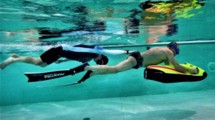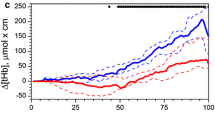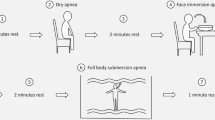Cerebral blood flow was studied in humans during performance of a diving reaction simulated by cold + hypoxia + hypercapnia, as well as in a cold test, on respiration of a 7% hypercapnic mix, and in the Genche test (breath-holding). A total of 18 subjects (18–22 years old with no special physical training were studied. Cerebral blood fl ow was recorded by transcranial dopplerography. Simulated diving increased the linear cerebral blood fl ow rate by 82.3 ± 15.2% and decreased the pulse index by 77.2 ± 13.1%. In the cold test, the linear blood fl ow rate remained unaltered, while the pulse index increased. There were no significant changes in these values on respiration of the 7% hypercapnic mix. In the Genche test, the linear blood flow rate increased by 52.3 ± 12.5% and the pulse index decreased by 64.5 ± 15%. The latent period of changes in cerebral blood flow in simulated diving (14–43 sec) indicated that the regulatory influences altering blood flow were metabolic in nature.
Similar content being viewed by others
References
T. I. Baranova, “Characteristics of the cardiovascular system in the diving reaction in humans,” Ros. Fiziol. Zh., 90, No. 1, 20–31(2004).
T. I. Baranova, R. I. Kovalenko, A. V. Mitrofanova, and I. N. Yanvareva, “Dynamics of measures of energy metabolism on adaptation to diving in humans,” Zh. Evolyuts. Biokhim. Fiziol., 46, No. 5, 411–420 (2010).
B. V. Gaidar, V. E. Parfenov, and D. V. Svistov, A Practical Handbook for Transcranial Dopplerography, VMA, St. Petersburg (1995).
V. P. Galantsev, Adaptation of the Cardiovascular System of Semi-Aquatic Amniotes, LGU, Leningrad (1988).
V. I. Evlakhov and I. Z. Poyasov, “Arterial and venous circulation in deep respiration in conditions of orthostatic and antiorthostatic stimuli,” Ros. Fiziol. Zh., 87, No. 1, 37–42 (2001).
T. V. Kozyreva, “Central and peripheral thermoreceptors. Com parative analysis of prolonged adaptation of the body to cold and noradrenaline,” Ros. Fiziol. Zh., 91, No. 12, 1492–1503 (2005).
A. D. Nozdrachev and M. P. Chernysheva, Visceral Reflexes, LGU, Leningrad (1989).
A. A. Nurmatov, B. I. Tkachenko, A. V. Samoilenko, and A. A. Yurov, “Changes in systemic hemodynamics on exposure of the cooled body to hypoxia,” Ros. Fiziol. Zh., 63, No. 6, 808–814 (1987).
V. E. Parfenov, Transcranial Dopplerography: Dissert. Doct. Med. Sci., St. Petersburg (1996).
A. Yu. Rosin, Dopplerography of the Cerebral Vessels in Children, Prognoz St. Petersburg Med. Center, St. Petersburg (2000).
J. V. Andersson, V. Y. Liner, A. Fredsted, and K. A. Schagatay, “Cardiovascular and respiratory responses to apneas with and without face immersion in exercising humans,” J. Appl. Physiol., 96, 1005–1010 (2004).
H. Bode, Pediatric Applications of Transcranial Doppler Sonography, Springer-Verlag, Wien (1988).
M. Buchheit, J. J. Peiffer, C. R. Abiss, and P. B. Laursen, “Effect of cold water immersion on postexercise parasympathetic reactivation,” Am. J. Physiol. Heart Circul. Physiol., 296, 421–427 (2009).
H. V. Carey, M. T. Andrews, and S. L. Martin, “Mammalian hibernation: Cellular and molecular responses to depressed metabolism and low temperature,” Physiol. Rev., 83, 1153–1181 (2003).
K. L. Drew, M. B. Harris, J. C. LaManna, et al., “Hypoxia tolerance in mammalian heterotherms,” J. Exp. Biol., 207, 3155–3162 (2004).
J. M. Gidday, “Cerebral preconditioning and ischaemic tolerance,” Nat. Rev. Neurosci., 7, 437–448 (2006).
M. Jeager, E. A. Hauth, H. M. Gissler, et al., “Angioplasty or stenting of extra- and intracranial vertebral artery stenoses,” Cardiovasc. Intervent. Radiol., 27, No. 1, 51–57 (2004).
F. Joulia, F. Lemaitre, P. Fontanari, et al., “Circulatory effects of apnoea in elite breath-hold divers,” Acta Physiol. Oxf., 197, No. 1, 75–82 (2009).
T. Kjeld, F. C. Pott, and N. H. Secher, “Facial immersion in cold water enhances cerebral blood velocity during breath-hold exercise in humans,” J. Appl. Physiol., 106, 101–106 (2009).
E. W. Lang, J. Lagopoulos, and J. Griffith, “Cerebral vasomotor reactivity testing in head injury: the link between pressure and flow,” Neurol. Neurosurg. Psychiatry, 74, 1053–1059 (2003).
S. L. Mironov, K. Langohr, and D. W. Richter, “Hyperpolarizationactivated current, Ih, in inspiratory brainstem neurons and its inhibition by hypoxia,” Eur. J. Neurosci., 12, 520–526 (2000).
S. M. Otis and E. B. Ringelstein, “Transcranial Doppler sonography,” in Introduction to Vascular Ultrasonography, W. L. Zwiebel (ed.), W. B. Sounders Co., Philadelphia (1992), pp. 145–171.
M. W. Panneton, Q. Gan, J. Le, et al., “Activation of brain-stem neurons by underwater diving in the rat,” Front. Physiol., 3, No. 111, 1–13 (2012).
J. M. Ramirez, L. P. Folkow, and A. Blix, “Hypoxia tolerance in mammals and birds: From the wildness to the clinic,” Annu. Rev. Physiol., 69, 113–143 (2007).
E. K. Schagatay, J. P. A. Andersson, M. Hallen, and B. Palsson, “Physiological and genomic consequences of intermittent hypoxia selected contribution: Role of spleen emptying in prolonging apneas in humans,” J. Appl. Physiol., 90, 1623–1629 (2001).
A. L. Schaefer, B. A. Young, and B. V. Turner, “The effects of cold exposure on bloodflow distribution in sheep,” Therm. Biol., 7, No. 1, 15–21 (1982).
Author information
Authors and Affiliations
Corresponding author
Additional information
Translated from Rossiiskii Fiziologicheskii Zhurnal imeni I. M. Sechenova, Vol. 100, No. 5, pp. 624–633, May, 2014.
Rights and permissions
About this article
Cite this article
Baranova, T.I., Berlov, D.N. & Yanvareva, I.N. Changes in Cerebral Blood Flow on Performance of a Diving Reaction in Humans. Neurosci Behav Physi 46, 36–41 (2016). https://doi.org/10.1007/s11055-015-0195-4
Published:
Issue Date:
DOI: https://doi.org/10.1007/s11055-015-0195-4




